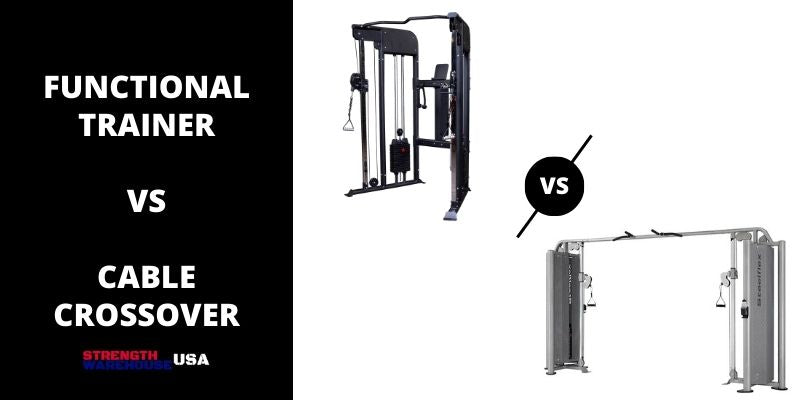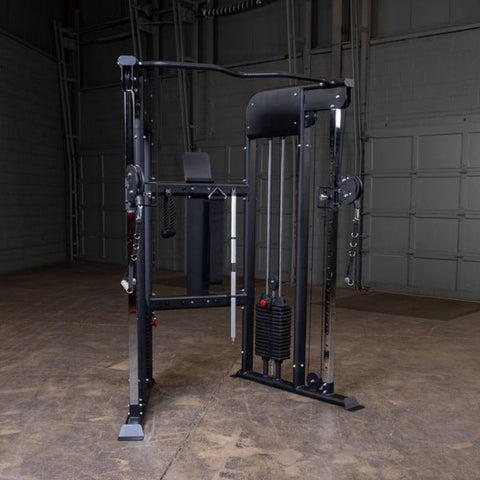When people think of cable systems, these two machines come to mind: functional trainers and cable crossover machines. They are some of the most preferred gym equipment if you are serious about improving your fitness levels.
Both machines are similar at face value, but they have significant differences in their functionality. Understanding the differences between them is key to making the right choice for your fitness goals and your workout space.
A cable crossover machine, is a larger version of a functional trainer, featuring a long bar on the top of the frame. On the other hand, a traditional functional trainer offers a more compact and versatile weight training experience.
Is the functional trainer the best fit for you? Or a cable crossover? Let’s find out how they can contribute to your workout routine in this article.
Understanding the Cable Machines
Cable crossover machines and functional trainers share many similarities, especially in functional training workouts. For instance, they both rely on cable-based resistance mechanics with a wide range of motion, enabling users to perform various exercises like a cable bicep curl, cable flys for chest muscles, functional movements, overall strength training, and compound exercises.
A functional trainer cable machine has easy-to-adjust cable angles, pull-up bars, and weight stacks for your strength training. It is designed to encourage movements that mimic everyday activities, promoting overall muscle balance and stability. A functional trainer is a great addition to your home gym as a standalone option or in conjunction with a power rack.
Both machines have mechanisms for exercises that isolate specific muscle groups, with the cable crossovers serving best as an accessory movement performed for higher volume or repetitions.
If you are considering either of these machines, also look into factors like space availability, your training goals, budget, and other preferences.
To keep it simple:
-
Functional trainers are compact and space-saving, less expensive, and will fit in both home gyms and commercial gyms.
-
Cable crossover machines are bigger, wider in design, and more expensive. They fit in commercial gyms and some home gyms too.
Functional Trainer vs Cable Crossover Similarities
As we’ve established earlier, both functional trainers and cable crossover machines share some similarities as they are part of the same family of fitness equipment, each serving as a versatile piece of equipment. However, they are also different in the way they are designed.
Now, they use weighted cables for resistance training as well as adjustable cable column to make it convenient for most fitness levels.
Key similarities between these machines include
Multi-directional pulleys
The adjustable pulleys on functional trainers move freely in multiple directions, mimicking everyday activities. This makes exercises like squats, lunges, and rows ideal for functional training.
Adjustable Cables
Most trainers have adjustable cables that can be raised or lowered, making it easy to target different muscle groups. Unlike other gym equipment, like a smith machine, functional trainers work off dual pin-loaded weight stacks attached to cables and pulleys.
Need to focus on the upper body? Raise the cables for chest flys. Want to hit your hamstrings? Lower them for cable deadlifts.
Smooth pulley system
This guarantees durability, performance, and provides a seamless and consistent cable glide. You will immediately notice the fluidity and precision of your exercises once you try them.
Keep in mind that specific features vary depending on the model you choose. Yet these key aspects will help you decide which is perfect for you.
Attachments galore
Most cable trainers come equipped with universal handle attachments and have the ability to add-on straps, and bars, expanding your workout options beyond just pulling and pushing motions.
Functional Trainer vs Cable Crossover Differences
There's really only one main difference between the two dual weight stacks cable machines. Simply put:
A cable crossover has a long horizontal frame with pulleys on both ends. It allows two users to workout individually with plenty of space.It also works well for chest presses and tricep extension.
A versatile functional trainer is much more compact! It can be less than half the width of a cable crossover.
Cable crossover machines are commonly found in commercial gym settings, known for their long crossbars and multiple selectorized weight stacks.
Functional Trainer vs Cable Crossover: Pros and Cons
Functional Trainer Pros
-
Versatility: A functional trainer shines in its capacity to perform a wide range of exercises, mimicking natural movements. This makes it suitable for functional training, which emphasizes movements that translate to everyday activities. From squats and lunges to chest press and rows, you can target various muscle groups with a single machine and really achieve a good full-body workout.
-
Space-saving: Compared to having multiple machines for different exercises, a functional trainer is a compact solution. This is ideal for home gyms or areas with limited space, so you can easily maximize your workout area.
-
Safety: The cable system provides controlled movements, minimizing the risk of injury. This is beneficial for beginners or those recovering from injuries because it is a safe way to learn and recover.
-
Adjustability: You can modify the weight, height, and angle of your workouts with functional trainers because they are very flexible. This caters to different fitness levels and targets specific muscle groups, ensuring a personalized and progressive workout experience
Functional Trainer Cons
-
Narrow Footprint: While this might be a pro for most users, especially if you're putting this in a home gym - it can make it difficult to perform cable crossover and fly type movements. The narrow frame maybe be too narrow of a starting point for some users.
Cable Crossover Pros
-
Great for chest mass and strength: Cable crossover exercises maximize hypertrophic response in the pectoral muscle, which means that even without a significant amount of load being used, you can stimulate muscle growth and strength development in the chest. The adjustable height pulley systems allow for a full range of motion, targeting the chest muscles from various angles. The wide separation of the weight plates on a cable crossover can provide a superior exercise compared to when done on a functional trainer.
-
Low injury risk, low joint impact: It is a safer option for strength training when done in proper form, especially for people with joint issues or recovering from injuries. The guided motion reduces the risk of strain or imbalance, while the smooth movement minimizes joint stress compared to other exercises.
Cable Crossover Cons
Shared Cons for Cable Machines
-
Lat Pulldowns: Performing a traditional lat pulldown movement on either a functional trainer or cable crossover is not ideal. The lack of leg hold down feature really limits your capability here. If you're looking to get this functionality out of your cable machine, make sure there is a leg hold down attachment compatible with your machine, or opt for a separate lat pulldown machine.
-
Assembly required: Most cable machines will require assembly upon delivery - depending on your means of purchase, which many people will find time-consuming and inconvenient. However, once assembled, these cable machines offer a range of workouts and variety.
-
Learning Curve: The initial learning curve associated with cable machines may deter some users, particularly beginners or those accustomed to traditional gym equipment like the Smith machines or free weights. You will require time and practice to master the proper technique involving grip positions, the pulley ratio, and pulley systems in general. But once you get familiar, you access to workout versatility is only limited by your creativity.
-
Maintenance: This could pose a bit of concern, especially for models with complex pulley systems and dual-weight stacks. Unlike power racks or free weights, which typically require minimal upkeep, cables machines need to be maintained more frequently to prevent cable wear issues or pulley malfunctions. And this is applicable for commercial gyms with high usage rates because equipment reliability is crucial for uninterrupted workouts.
Note: Some cable machines do not come with an array of attachments. We recommend getting some cable attachments or a cable attachment bundle with a storage rack.
Making the Right Choice for Your Goals
Your fitness goals are unique to you, and selecting the right equipment can make all the difference in reaching them. Let’s find out what’s best for you.
Who Should Buy a Functional Trainer?
Functional trainers are versatile options suited to a variety of fitness enthusiasts. They're great for those who want full-body workouts, some lower-body workouts, and functional training without breaking the bank.
With adjustable cables and multiple attachments, they are a compact and efficient workout solution. If you're looking to make the most of your workout space while sticking to a budget, a functional trainer is a smart choice.
(You should also check out our guide on lesser-known exercises with functional trainers.)
-
Ideal for: people focused on full-body workouts and functional training. They are excellent at simulating everyday activities, making them ideal for improving strength, balance, and core stability.
-
Space-saving solution: They are often compact compared to multiple machines, which makes them the best cable machines for home gyms or areas with limited space.
-
Versatility is key: With multi-directional pulleys, adjustable cables, and various attachments, they support a wide range of exercises, catering to various fitness levels.
-
Budget-friendly option: Generally, functional trainers are more affordable compared to most cable crossover machines.
Who Should Buy a Cable Crossover Machine?
Cable crossover machines are perfect for commercial gyms and home gyms with a ton of space. They can be considered superior upper-body chest exercises, and if that’s your thing, good choice. They have consistent resistance and multiple grip positions, thus being suitable for sculpting and strengthening the chest, shoulders, and arms.
Plus, their versatility with accessories like tricep ropes and ankle straps allows for a dynamic workout routine tailored to personal preferences.
These machines are a great fit for those who enjoy a variety of exercises and want to keep their workouts engaging.
-
Ideal for: Gym enthusiasts focused on muscle isolation and sculpting. Bodybuilders and those who wish to concentrate on particular areas will find them ideal, as they are excellent at precise, controlled movements for particular muscle groups.
-
Focus on exercise preferences: ideal for those who enjoy controlled, single-joint exercises like cable flies, tricep extensions, single arm crossovers, lateral raises, and lots more.
-
Budget consideration: Cable crossovers tend to be more expensive than functional trainers.
-
Size Constraints: Cable crossovers have a much larger footprint than functional trainers and may not be the best option for space conscious gym owners
Conclusion and Recommendations
Ultimately, the best choice between a functional trainer and a cable crossover machine depends on your individual fitness goals and preferences.
If you prioritize versatility, space-saving in your home gym, and functional training, a functional trainer is perfect for you. Check out our article reviewing the best functional trainers!
But if you want to benefit from both functional and weight training within one comprehensive machine, a cable crossover machine might be your best fit.
If you are unsure about the type of crossover machine you need, get in touch with us, and we will be happy to help.
Functional Trainer Versus Series





Leave a comment